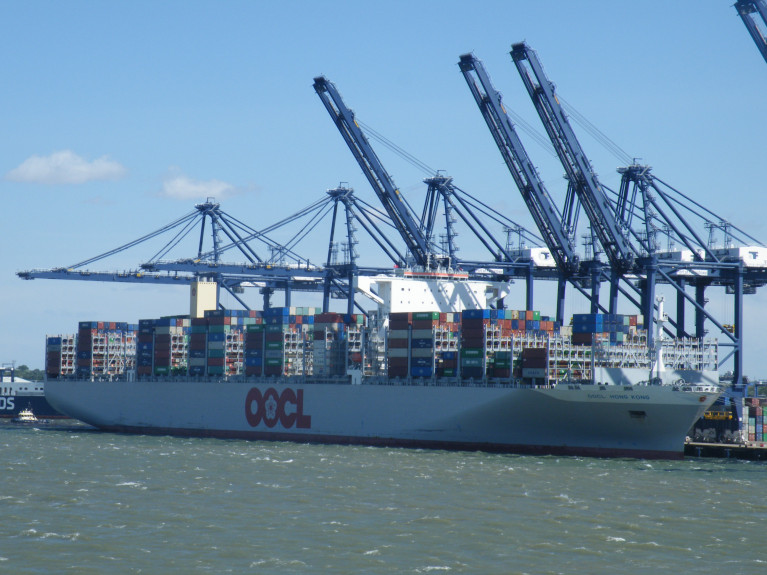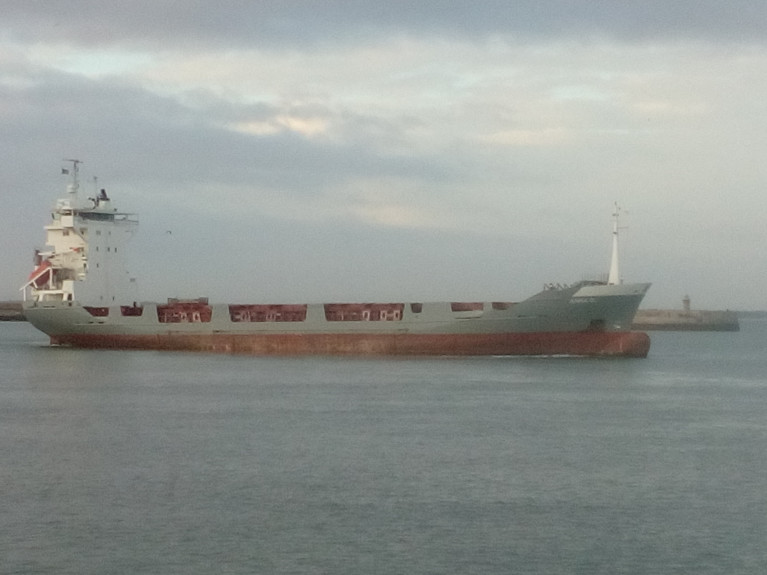Displaying items by tag: Anna G
Dun Laoghaire Containership Anna G Arrives At UK's Biggest Box-Boat Port Where Giant Asia-Europe Ship Is Berthed
The 'feeder' containership Anna G which departed Dun Laoghaire Harbour following lengthly repairs was tracked by Afloat having arrived this morning to Felixstowe, the UK's biggest box-boat port, writes Jehan Ashmore.
The 101m Anna G (3,992grt) is described as a 'feeder' containership with a carrying capacity of 509 TEU (twenty-foot equivelent unit) however such small ships ply a vital role in the overall global logistics supply-chain by loading/discharging containers for short-sea passages.
Feederships such as Anna G make containership transhipments by connecting to/from considerably larger ships that have travelled on ocean voyages linking continents.
For example, the giant 400m long OOCL Hong Kong (210,890grt) which too is currently berthed at the Suffolk port, had sailed from Singapore in Asia. The ship's next European port of call is Gdansk in Poland.
As previously reported on Afloat, when OOCL Hong Kong entered service in 2017, the G-class vessel was the largest ever containership built and the first to surpass the 21,000 TEU capacity threshold.
The shipowners of Anna G are the German operator Reederei Gerdes based in Haren. The family owned company operates 11 ships, however the ship which had been in Dun Laoghaire since mid-November, is the only containership as the rest of the fleet comprises of short-sea general cargoships.
As for OOCL Hong Kong, the giant ship's operator is Orient Overseas Container Line, commonly known as OOCL, which is a container shipping and logistics service company with headquarters located in Hong Kong, China. They have 59 vessels of different classes with capacity varying from 2,992 to 21,413 TEU.
The Port of Felixstowe, operated by Hutchinson Ports comprises of two quays, Trinity Quay where Anna G is berthed along with other containerships and to the east, Berths 8 & 9 where OOCL Hong Kong is alongside. These berths can handle the largest containerships in service.
At the western end of Trinity Quay is where the River Orwell flows downriver from the Port of Ipswich from where Arklow Shipping's short-sea general cargoships and bulkers have down the decades traded. In particular in the transportation of agricultural products from farms in East Anglia.
Repaired Containership Finally Departs Dun Laoghaire Harbour on New Year's Day Bank Holiday
A containership which was under tow from Carlingford Lough to Dun Laoghaire Harbour in mid-November finally departed yesterday following engine repairs that lasted much longer then expected, writes Jehan Ashmore.
Anna G with a capacity for 515TEU containers departed on the Monday Bank Holiday following New Year's Day that fell on Saturday. As such the long weekend was busy as when the ship eased off the Carlisle Pier the departure was observed by many walkers thronging the harbour's East Pier.
Originally, Anna G was to remain in the port to effect engine repairs for an estimated four weeks according to Dun Laoghaire-Rathdown County Council as previously reported, however the vessel operated by German shipowner Reederei-Gerdes would stay in port beyond this timeframe.
It was last month when various engine parts had to be shipped to Germany to be machined and though they were returned to the ship, work that was to be concluded before Christmas did not arise.
This forced Anna G to remain in the harbour and into the New Year, coupled with technicians away on leave for the festive period. This further delayed the works until their return last week to complete repairs.
Previously on Sunday, Anna G departed (albeit within the harbour) from St. Michael's Pier to vacate berth No. 4. This was to due operational reasons, though on that same day saw the arrival to the same berth of Irish Lights aids to navigation tender ILV Granuaile from Belfast Harbour.
As for the 5,210tdw containership which shifted to the adjacent Carlisle Pier at berth No. 2 which is on the far side of the pier opposite of the East Pier.
On the next day a Dublin Port pilot cutter DPC Tolka arrived mid-afternoon to embark a pilot on board the Limassol registered Anna G.
This led to the ship cautiously easing off the Carlisle Pier while using a bow thruster and also going astern before swinging the bow off the East Pier's bandstand from where bystanders saw the 101m ship get underway.
Having swung around sufficiently, Anna G was facing the harbour mouth and with that a single blast of the ship's horn also marked the long awaited departure of the ship which had been in port for more than seven weeks.
Anna G then set off into Dublin Bay and soon afterwards the DPC Tolka returned to disembark the pilot while off Scotsman's Bay. With that procedure concluded the ship continued on a southerly course with the passing off The Muglins beacon off Dalkey.
The containership's next port of call is the Port of Felixstowe, Britain's biggest 'box'-boat port.
As of 12 noon today, Anna G had already passed Land's End, Cornwall and was approaching the eastbound shipping lane of the English Channel.
Tomorrow night the vessel is due to arrive at the North Sea port.






























































